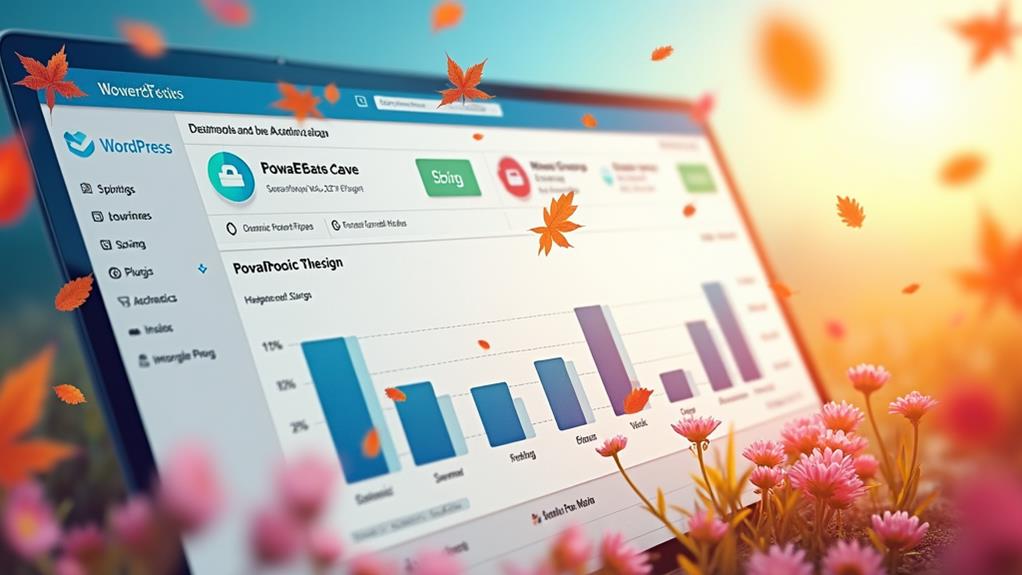To plan effective seasonal content for social media, begin by mapping out key cultural dates and trends, incorporating audience insights to tailor messaging that resonates. Utilize content calendars for timely delivery and maintain a balance between engaging narrative-driven posts and strategic promotions. Creative storytelling and interactive elements, such as quizzes and challenges, enhance engagement and brand loyalty. Harness the power of social media listening tools to adapt swiftly to emerging trends, ensuring relevance and resonance. Finally, leverage analytics to optimize future campaigns and maximize engagement. With these strategies, your seasonal content can capture your audience's attention like never before.
Key Takeaways
- Develop a content calendar to schedule posts aligned with key seasonal dates and brand values.
- Use audience insights and social media listening tools to identify relevant seasonal themes.
- Begin planning 4-6 months in advance for effective promotional strategies.
- Balance content with a 70/30 ratio of engaging posts to promotional messages.
- Track performance metrics to refine and optimize future seasonal content strategies.
Understanding Seasonal Content
Understanding seasonal content is pivotal for brands aiming to enhance their relevance and engagement throughout the year. By tapping into seasonal themes, brands can craft content that aligns with the cyclical nature of audience interests and cultural celebrations. This strategic alignment requires a nuanced understanding of audience insights, ensuring that the content resonates at the right time with the intended demographic.
Seasonal content is categorized into time-based and event-based themes. Time-based content includes seasonal narratives such as summer activities or back-to-school promotions. Event-based content focuses on specific holidays like Christmas or Halloween. Both types are designed to evoke emotional connections and peak consumer interest, driving higher engagement rates.
However, to maximize impact, brands must explore audience insights, identifying which seasonal themes are most relevant to their target market.
A content calendar is an invaluable tool for this process, enabling brands to stay ahead of seasonal trends. By planning and scheduling content that is culturally sensitive and aligned with core brand values, companies can avoid missteps and stand out in crowded markets.
Ultimately, creating unique seasonal narratives fosters stronger relationships with audiences, ensuring sustained engagement across various platforms.
Key Dates and Trends
As brands seek to harness the power of seasonal content, a keen focus on key dates and emerging trends becomes imperative. For 2023, pivotal dates such as Halloween, Black Friday, and Christmas present opportunities for brands to develop engaging holiday themes that resonate with audiences.
The significance of these dates, particularly Christmas, is underscored by the fact that they account for approximately 25% of annual retail sales. Consequently, early planning, ideally four to six months in advance, is essential to crafting effective promotional strategies that align with consumer expectations.
Black Friday, now a global phenomenon, sees brands launching promotions in early November. This strategic timing aims to capture pre-event consumer interest and leverage the heightened shopping fervor.
Meanwhile, Christmas remains a dominant force, with UK consumers expected to spend around £1,108, a third of which is earmarked for gifts. This spending behavior demands targeted promotions that cater to gift-giving themes.
Additionally, seasonal trends are often shaped by external cultural events, such as movie releases or viral social media content, allowing brands to tap into these narratives for increased engagement. By strategically aligning with these trends, brands can amplify their seasonal content impact.
Aligning With Cultural Moments
Maneuvering the intersection of culture and commerce presents an opportunity for brands to enhance their relevance through strategic content alignment with cultural moments. This approach fosters cultural relevance and audience resonance, driving seasonal authenticity and messaging consistency. Utilizing a content calendar, brands can adapt to seasonal trends, guaranteeing their content aligns with significant cultural events. Social media listening tools further aid in tracking conversations, allowing for precise trend adaptation and brand alignment.
| Component | Benefit |
|---|---|
| Content Calendar | Timely and relevant posts |
| Social Media Listening | Tailored content for audience values |
| Storytelling | Emotional connection and loyalty |
| Brand Values Integration | Authentic audience connection |
Celebrating cultural events through emotional storytelling allows brands to evoke powerful audience connections. By weaving their core values into narratives that align with cultural moments, brands can highlight their unique offerings, fostering audience connection and loyalty. This approach not only capitalizes on shared experiences but also guarantees seasonal authenticity.
Moreover, aligning content with cultural moments guarantees brands remain top-of-mind, potentially boosting traffic and conversions. By maintaining messaging consistency and adapting to emerging trends, brands can secure a prominent place in the cultural zeitgeist, further deepening their relevance and cultivating lasting relationships with their audience.
Crafting Unique Brand Narratives
In the domain of digital marketing, crafting unique brand narratives during seasonal campaigns serves as a significant strategy to distinguish brands in a competitive landscape. By weaving core values into compelling stories, brands can achieve narrative consistency and enhance audience relatability. This approach encourages emotional storytelling, evoking sentiments such as joy and nostalgia, making the content not only engaging but also memorable.
Seasonal themes provide a rich backdrop for integrating creative visuals that highlight unique product offerings, enabling brand differentiation amidst market saturation.
Brand authenticity plays a significant role in this narrative crafting. Authenticity, combined with relatable narratives, humanizes the brand, fostering deeper connections and increasing brand loyalty. It is essential for these stories to reflect the brand's mission and align with the audience's values and traditions, ensuring campaign alignment.
This alignment can drive both engagement and conversions, as audiences are more likely to connect with content that echoes their own experiences and beliefs.
Utilizing sophisticated storytelling techniques, brands can transform seasonal moments into opportunities for meaningful interaction. By crafting narratives that resonate on an emotional level, brands can effectively capture consumer interest, making them stand out in the digital marketing sphere.
Engaging Storytelling Methods
In the domain of social media, engaging storytelling methods that evoke emotional connections are pivotal in crafting seasonal content that resonates with audiences.
By humanizing brand narratives, companies can create authentic connections that not only captivate but also encourage audiences to share their own stories, thereby broadening the content's reach.
This approach not only aligns with current trends emphasizing authenticity and relatability but also positions brands to effectively leverage cultural moments and enhance community engagement during seasonal events.
Evoking Emotional Connections
How can brands tap into the power of emotions to enhance their seasonal social media content? By weaving nostalgic themes and emotional triggers into their storytelling strategies, brands can create engaging narratives that resonate deeply with their audience.
Nostalgic themes, such as memories associated with festive seasons or notable life milestones, can evoke a sense of longing and joy. These emotional triggers not only foster an immediate connection but also enhance the recall of the brand message.
Engaging storytelling that leverages emotional connections can greatly boost audience engagement. Content that evokes joy or nostalgia is more likely to be shared, as individuals enjoy content that resonates with their personal experiences.
This emotional resonance can lead to increased engagement metrics, as people are more inclined to engage with and discuss content that stirs their emotions.
Moreover, integrating relatable seasonal messaging into storytelling amplifies the brand's message and crafts memorable experiences. This approach not only drives higher conversion rates but also cultivates brand advocacy.
As audiences form deeper emotional bonds with the brand through these narratives, they become more likely to advocate for and remain loyal to the brand, thereby enhancing long-term brand success.
Humanizing Brand Narratives
Crafting authenticity within brand narratives stands as a powerful tool in today's digital landscape, particularly when engaging storytelling methods are employed.
By integrating brand authenticity into seasonal narratives, companies can create a compelling connection with their audience, fostering loyalty and interaction. Narrative techniques that evoke emotions such as joy and nostalgia are particularly effective, as they resonate deeply with audiences and enhance brand loyalty.
To humanize brand narratives effectively, consider the following strategies:
- Utilize Authentic Stories: Align stories with the brand's mission during seasonal events to forge emotional connections, making audiences more likely to engage.
- Incorporate Audience Experiences: Include testimonials and community stories to cultivate a sense of community, driving higher interaction rates on social media.
- Highlight Unique Offerings: Position product offerings within personal or cultural experiences to stand out in a crowded marketplace.
- Employ Emotional Storytelling: Share heartfelt stories or community initiatives during seasonal campaigns to boost engagement metrics like shares and comments.
Interactive Content Strategies
To enhance seasonal content on social media, incorporating interactive strategies like quizzes, polls, and user-generated content contests can greatly boost audience engagement by up to 70%.
By tailoring these interactive elements to specific platforms—such as Instagram for quick polls and Facebook for in-depth quizzes—brands can maximize participation and improve user experience.
Regular performance analysis of these interactive formats allows for strategic refinement, ensuring future content aligns with audience preferences and engagement trends.
Boost Audience Engagement
Engaging a social media audience effectively requires a strategic approach that leverages interactive content to boost participation and enhance user experience. Incorporating elements like interactive quizzes and community contests forms the backbone of modern engagement strategies. When thoughtfully implemented, these tactics not only enliven content but also foster deeper connections through content personalization and audience feedback.
- Interactive Quizzes: Craft quizzes that resonate with your audience's interests, encouraging them to share results, thereby expanding your reach organically.
- Community Contests: Initiate creative challenges, such as photo or video contests, to increase brand interactions and promote a sense of community.
- Visual Storytelling: Engage followers with choose-your-own-adventure posts that utilize dynamic visual storytelling, sparking emotions and enhancing audience participation.
- Content Personalization: Tailor interactive content to specific platforms, such as Instagram polls or TikTok challenges, to optimize user experience and maximize engagement.
Analyzing engagement metrics from these strategies is essential. Brands that adjust their tactics based on audience feedback report up to a 30% improvement in engagement.
Platform-Specific Strategies
Maneuvering the diverse landscape of social media platforms necessitates a nuanced approach to interactive content strategies, especially when planning for seasonal campaigns. Understanding platform nuances is critical, as each platform offers unique features that can be creatively leveraged to boost engagement.
For instance, Instagram Stories' question stickers and Facebook Live polls provide opportunities for real-time audience interaction, aligning seamlessly with seasonal themes to capture audience preferences. Interactive content, such as polls and quizzes, is proven to increase engagement by up to 70%, a significant advantage for campaigns seeking to resonate with their audience during peak seasons.
Moreover, incorporating gamification elements like seasonal-themed challenges or contests can amplify user-generated content, effectively doubling brand visibility and fostering a sense of community.
By aligning content with cultural moments, such as holiday-themed trivia on TikTok, brands can tap into trending topics, enhancing both shareability and engagement rates. Tailoring interactions to platform-specific strengths not only appeals to existing audience preferences but also attracts new followers.
This strategic focus on platform nuances guarantees that seasonal campaigns are both timely and impactful, setting the stage for enhanced brand loyalty and greater community connection.
Performance Analysis Tactics
Effective performance analysis tactics are essential for optimizing interactive content strategies on social media, as they provide insightful data to refine and enhance engagement efforts. By examining audience behavior and content timing, brands can strategically tailor their approaches to maximize impact.
Interactive elements like quizzes, polls, and games have proven to notably boost audience engagement, with studies showing they generate up to two times more conversions than passive content. Understanding how these elements perform across different platforms is critical.
- Completion Rates: Analyze how many users finish interactive content. High completion rates indicate effective engagement, suggesting content resonates with the audience.
- Shares and Virality: Measure how often content is shared. High share rates can amplify brand visibility, enhancing the reach through organic audience expansion.
- Emotional Resonance: Content that emotionally connects with users can increase engagement by 70%. Track emotional responses through comments and reactions.
- Platform-Specific Engagement: Tailor content to platforms like Instagram Stories, where polls can increase interaction by 20%.
Utilizing tools like Google Analytics and social media insights is essential for tracking these metrics, providing actionable data to fine-tune interactive strategies and align them with evolving trends and audience behaviors.
Balancing Promotions With Engagement
Achieving an ideal balance between promotions and engagement is essential for crafting compelling seasonal social media content. Effective promotion strategies should align with engagement techniques to guarantee content diversity and resonance. Aiming for a 70/30 balance—70% engaging, value-driven posts and 30% promotional messages—leverages audience insights to foster trust and loyalty.
Seasonal themes offer a canvas for creative storytelling that emotionally connects, potentially boosting engagement by 60% over standard promotional content.
Utilizing user-generated content (UGC) during seasonal campaigns can greatly impact purchasing decisions, as 79% of consumers find UGC influential. This approach not only cultivates community engagement but also enhances brand authenticity.
Strategically planning promotional posts around major holidays allows brands to capitalize on peak shopping periods while maintaining the integrity of value-driven content. Here, content diversity is key, as 61% of consumers favor brands offering educational or valuable content during these times.
Analyzing social media engagement metrics provides a foundation for refining the promotional-to-engagement content ratio. This data-driven approach guarantees future seasonal strategies are tailored to audience responses, enhancing both trust building and loyalty cultivation.
Implementing these insights fosters a dynamic and interactive social media presence.
Tools for Content Planning
In the ever-evolving landscape of social media marketing, leveraging the right tools for content planning is essential to executing successful seasonal campaigns.
Utilizing a strategic blend of content scheduling, design tools, and analytics can greatly enhance the impact of your seasonal themes. Here's how:
- Content Scheduling: Platforms like Hootsuite and Edgar are indispensable for scheduling social media posts in advance. This guarantees that your content aligns seamlessly with seasonal themes and promotions, maximizing timely engagement.
- Design Tools: Canva is a powerful ally for crafting visually appealing graphics. By tailoring designs to specific seasonal campaigns, you can strengthen your visual branding and capture audience attention more effectively.
- Audience Insights and Performance Metrics: Tools such as Iconosquare provide key analytics on the performance of your seasonal content. This data allows for strategic adjustments and helps refine engagement strategies based on audience interaction.
- Campaign Tracking: Implementing UTM parameters offers detailed insights into the effectiveness of seasonal campaigns. This enables precise tracking of traffic sources and user engagement metrics, which are essential for optimizing future initiatives.
Measuring Campaign Success
As tools play an integral role in planning, their importance extends beyond preparation to the critical phase of evaluating campaign success. In the domain of seasonal content, measuring success hinges on key performance indicators that illuminate audience engagement and conversion. Audience segmentation and campaign timing are pivotal in tailoring content to resonate with specific demographics, enhancing the relevance and effectiveness of your campaigns.
Engagement metrics, such as likes, shares, and comments, serve as primary indicators of audience interaction and content resonance. Complementing this, analyzing website traffic through tools like Google Analytics allows for a deeper understanding of how seasonal posts drive site visits. Setting up UTMs (Urchin Tracking Modules) can pinpoint traffic sources, offering precise insights into campaign performance.
Moreover, monitoring conversion rates and sales provides a tangible measure of the campaign's impact on revenue and return on investment (ROI). By attributing sales to specific seasonal efforts, businesses can gauge their financial success.
Frequently Asked Questions
How to Plan a Social Media Content Calendar?
To effectively plan a social media content calendar, integrate content scheduling and audience engagement strategies. Utilize analytics to identify ideal posting times, employ scheduling tools for consistency, and regularly update content to reflect emerging trends and audience interests.
What Is Seasonal Social Content?
Seasonal social content refers to strategically crafted messages aligning with holiday trends and seasonal changes, aimed at boosting audience engagement. It leverages timely themes to enhance relevance, connect culturally, and differentiate brands in competitive markets.
How Do You Plan a Seasonal Campaign?
To plan a seasonal campaign, strategically align content with cultural events, focusing on the target audience. Establish clear campaign goals, integrating past analytics for refinement. Balance promotional and engaging content to enhance audience connection and achieve success.
How to Create a Content Plan for Social Media?
To create a content plan for social media, conduct thorough audience analysis to tailor content themes that resonate. Blend creativity with trend-focused strategies to craft engaging narratives, ensuring alignment with audience behaviors and preferences for best engagement.
Conclusion
Seasonal content planning for social media demands a strategic approach that integrates key dates, cultural moments, and trend analysis. Crafting unique brand narratives through engaging storytelling methods and interactive strategies can enhance audience connection. Balancing promotional efforts with meaningful engagement guarantees audience retention and loyalty. Utilizing advanced tools for content planning optimizes efficiency and effectiveness. Measuring campaign success through analytical metrics provides insights for continuous improvement, guaranteeing alignment with evolving trends and audience preferences in a dynamic digital landscape.




